CULTURE IN THE DEVELOPING WORLD
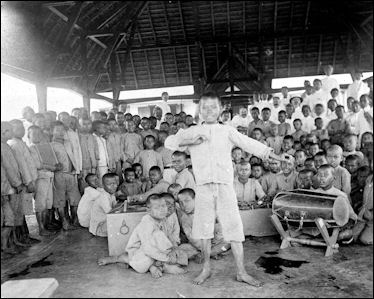
Entertainment in the old days
in Indonesia The distinction between art and functionalism are very thin. Many things that considered art in the West are used in everyday life. Henry Glassie, an expert on art in the developing world, wrote, "The process of skilled creation is not divided from quotidian flow. It belongs to the daily round of work, and even its most glorious products are meshed in commerce and destined for roles in human affairs,"
Art and crafts skills are often displayed in the clothes that villagers wear. Women in rural areas are known for their colorful clothes. They wear colorful shawls, embroidered skirts, headdresses and blouses. Often times each village has its own distinct cloth pattern. Women wear lots of gold and silver bracelets and jewelry, which of represents the family's wealth. Gold is often bought as a hedge against inflation.
Music in the Developing World
Music is found in every culture in the world. One thing that unifies villagers is their music. Many like to sing and dance. Often they sit glued to cassette players or radios listening to their favorite singers. Most music is sold in the form of bootleg cassettes of CDs.
Techno, house music, rock, heavy metal and hip hop are popular with young villagers. Often local language versions of the music forms are available. Old people prefer sentimental music with syrupy synthesized string arrangements and wailing vocal. They enjoy singing and often get choked up and emotional at parties singing old songs about the seasons and lost love.
Popular Western entertainers include Tom Jones, Michael Jackson, Madonna and Britney Spears.
Film, Videos and DVDs in the Developing World
These days most villagers have access to DVDs and videos. Most small town and large villages have video or DVD rental shops or video rooms with scheduled video shows. Even in small, remote villages without electricity, people can watch videos in a friends house on a VCR or DVD player powered by a generator or car battery.
The most popular films are American blockbusters, Indian Bollywood musicals, Hong Kong kung fu films, horror flicks, pornography and action adventures with Sly Stalone, Arnold Swarzeneger or Jackie Chan. Critically-acclaimed films are usually regarded as too slow and boring.
There is a booming market for boot-leg video cassettes and DVDs some of which are made by people running camcorders during a showing of the film in a movie theater. Some films at town cinemas are dubbed; others have subtitles.
Media in the Developing World
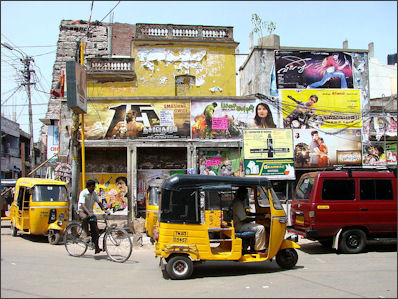
Bollywood movie posters in Madurai In villages with no electricity, light is supplied by kerosene lamps and radio is often the only entertainment. One villager in such a village in Mozambique told the Washington Post, “We have nothing else to do.”
The first exposure that many villages had to the outside world came through cheap mass produced Japanese transistor radios that began showing up in the 1960s. Televisions did not become commonplace until the 1980s and now there are found in almost every village in the world.
Radio is especially useful in places where there is no electricity and people are too poor to afford televisions, computers, satellite dishes and Internet service. In some cases villages tune in with radios that are hand cranked to provided them with power.
Radio stations in the developing world offer programs that deal with basic health and sanitation issues and family counseling and provide world news. Often the best way to deal with a problem or to get a message across is to package it in a soap opera. Dramas that deal with HIV/AIDS have done a better job in getting out the word on abstaining from promiscuous sex than pamphlets that say “use a condom.”
Through televison and advertising and videos, people in the developing world are now more aware of how people live in the developed world and aspire more to live like them. One of the big questions marks about how the world will progress in the future is how many people in the developing world will reach developed world levels and what impact this will have on resources, pollution and global warming. Aspirations are often shaped by the media.
Journalists often complain they are so poorly paid they feel they have to take bribes to make ends meet and often write promotion articles for money.
To advertise their products to people without television, Coca-Cola and other companies paint small vans with the company colors and logo, attach a huge loud speaker to the top of it, and drive it through towns and villages, blasting distorted jingles and pop songs.
Television in the Developing World
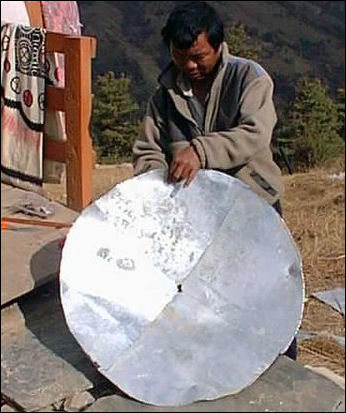
Hand-pounded satellite
dish in Nepal Televison have become common even in places with unreliable electricity or no electricity at all (they are powered by generators, batteries or car batteries). Many villagers even have access to satellite television or cable. There are also a lot of villages who have a satellite dish displayed prominently outside their house but don’t have it hooked up.
In some cases villagers make enough from selling cash crops such as coffee or cacao or livestock animals to afford a satellite dish for themselves. Often an enterprising individual in the village buys a satellite dish and runs cables from the satellite box to his neighbors televisions and charges them a fee. VCRs and DVD players are also common. DVDs and videos are often pirated.
Television watching has traditionally been something that people did communally: gathering around a single, generator-powered set in village to watch a soccer match or popular soap opera. These days many people have their own sets.
Many villagers are addicted to television. Some mud-and-thatch huts lack furniture but have television, which is often turned all day (or whenever programs are being broadcast or electricity is available) and often have ten or fifteen people sitting around it.
Studies have shown that people in developing countries that watch a lot of television have less children and buy more consumer goods than those who don't.
Television Shows in the Developing World
Standard fare on television includes musical variety programs, combination talk and game shows, and melodramas. Often the most popular television programs are soccer games and the news.
At one time Baywatch was watched by an estimated 2.4 billion people in 103 countries every week. Other popular shows over the years have included Dallas, Dynasty, Beverly Hills 90210, Seventh Heaven, The A-Team, Columbo, Star Trek, Sex in the City and 24 Hours.
CNN and BBC are seen throughout the world thanks to satellite and cable television. CNN reaches 210 countries and territories. It helped bring the Persian Gulf Wars, the O.J Simpson case, the Rodney King beating and the Los Angeles riot to television audiences all over the world,. MTV has given them Marilyn Manson, Oasis, Outkast, 50 Cents, Jennifer Lopez, shattered mirrors, and swivel-hipped women in thongs.
Soap Operas in the Developing World

Ramadan television in the Middle East Foreign soap operas are very popular. Successful ones have included “Santa Barbara” , “The Bold and Beautiful” , and the Brazilian soap opera “The Rich Also Weep” .
One soap opera that is popular throughout the developing world is “Simplemente Maria” , a Mexican-produced show originally broadcast from 1960 to 1971. Consisting of 448 episodes, it follows the story of a poor illiterate peasant woman who works hard, starts a sewing business and rises to be a world-famous fashion designer. In every country where “Simplemente Maria” has been shown the sales of sewing machines has soared.
Studies have showed that radio and television soap operas are much more effective in spreading messages about things like population reduction, environmental awareness and disease prevention than lectures, propaganda and pamphlets. Berlin-based Soap Operas for Social Change is involved in creating such soap operas with social messages all around the world.
Radio and Hand-Cranked Radios in the Developing World
Radio is the most widely utilized from of electronic media in the developing world. According to some estimates 80 percent of the world's population have access to radio.
With electricity being in short supply in many areas, radio is the main electronic medium for dispensing news and information. Shortwave radios, powered by batteries, solar energy, and car batteries, are the main sources of international news in places without electricity.
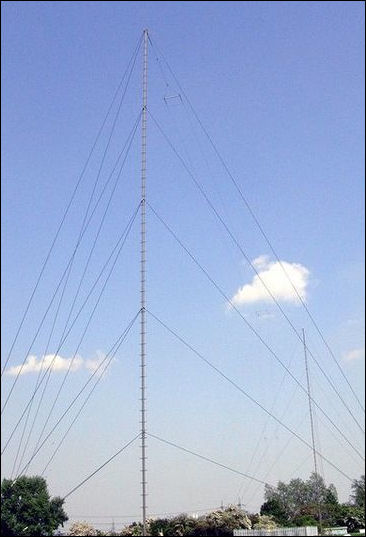
Transmitting station Many people got their news by radio listening to local-language programs produced by BBC World Service, Voice of American and the French Radio Monte Carlo. Shortwave radio listeners tune in regularly to the BBC. It is picked up in over 100 countries and is listened to by an estimated 140 million regular listeners.
Some of the most popular radio shows are government-produced education soap operas that deal with issues like family-planning, wife abuse, teenage marriage and unemployment. See Above.
The BayGen Power company in Cape Town South Africa produces a six-pound, low-fidelity, hand-cranked radio that sells for $40. Invented by British inventor Trevor Bayliss, it utilizes a spring (similar to the one used to role up seat belts) that is tightened with a hand crank and powers a generator when uncoiled. Useful in places where there is no electricity and batteries are prohibitively expensive, it operates for about 30 minutes on 20 seconds of hand cranking. The BayGen Power company also makes a hand-powered flashlight. Sony makes a waterproof radio powered by a hand crank generator. It is marketed as being useful in natural disaster and sells for $103.
Religious Radio in the Developing World
In remote areas and in many parts of the developing world, the faithful rely on radio for sermons, Bible and Koran readings, seminary courses and other forms of religious instruction and communication. Robert Fortner, a specialist in religious broadcasting at the U.S. -based Media Research Institute, told the Washington Post, “In the developed world, many people find that radio is about the only mechanism that is available. They hang on to it in the way people hang on to a life that after a tsunami...These programs connect people to a world that otherwise they have no access to. They indicate to these folks that someone “out there” cares enough about them to prepare programs in their own language and speak to them about their own struggles.” [Source: Kevin Sullivan, Washington Post, October 8, 2007]
Christianity is the dominant but not only the only force in religious radio. Muslim stations broadcasts Koranic recitations, news and music. Hindus, Buddhists and members of other religions have their own broadcasts. In addition to their religious programing, religious broadcasters also often provide world news along with programs that deal with basic health and sanitation issues and family counseling. Many of the Muslim broadcasts are funded by governments in predominately Muslim countries and are oriented towards Muslims.
The spread of religious radio programming has been made possible by the deregulation of the airwaves and the growth of private radio. In Africa, for instance, according to the BBC, there were just two radio stations that were not state-owned in the 1980s; now there are at least 3,000. Since 1991, when the Soviet Union broke up, more than 2,000 private radio stations, many with religious broadcasts have emerged in the 15 former Soviet republics.
Christian and Church Radio

radio tower in an Afghan villageRadio is useful for ambitious priests and preachers and other religious people who want to get their message out and find an audience. Even in remote villages in Mozambique or the steppes of Mongolia, radio listeners can tune into sermons by J. Vernon McGee, a Texas preacher, on Jesus and Saint Paul. There are at least a dozen major international Christian radio network that operate in nearly all the world’s countries and broadcast in 360 languages. Most originate in the United States, which has more than 2,000 domestic religious radio stations. But others originate from Britain, Sweden and places like Chile and the Philippines.
U.S.-based Trans World radio, a non-denominational Protestant network, is among the largest religion radio networks. With a budget of $40 million, raised through donations, it is broadcast in more than 200 countries. Trans World was broadcast to 2,800 stations globally in 2007, up from 1,600 in 2001. The Christian Broadcasting Network in Chesapeake Virginia produces foreign-language radio programs which are broadcast in many countries.
Some religion groups distribute $50 hand-crank radios with the help of local pastors. A handful of such radios can go a long way. Sometimes a single radio is all that is necessary to bring radio programming to a village. One Anglican pastor in a village in Mozambique told the Washington Post , “This brings more people to the church. Some people started going to church and gave up, and these programs convinced them to come back. Others have who have never been to church hear this and are convinced to become Christians.”
J. Vernon McGee is one of the world’s most widely-heard preachers. His program “Thru the Bible” is broadcast in 108 languages in 219 countries. Even though McGee died in 1988 his sermons have been kept alive by his followers and listeners who donate everything from pocket change to multi-million -dollar inheritances to keep the broadcasts going. The translations are often done by local preachers in the local languages and dialects. In some places McGee’s broadcasts are the only radio program available in the local language. A listener in Mozambique told Washington Post that McGee’s show is the only radio program he listens to. “It makes me feel good,” he said. “It explains things well. It gives us more than the Bible. It talks about how to live. It adds to what we are taught by our parents and our pastors. I learn about forgiveness. It teaches us to live better.”
Western Culture in the Developing World
Indigenous customs and cultural practices that have existed for thousand years are being usurped by low-common denominator Western culture. The older generation is often resistant to Westernization but not the younger generation. The government sometimes encourages Westernization because some old customs are considered primitive.
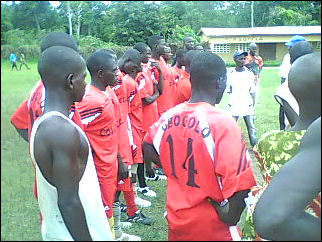
football in Africa Western culture has expanded into the cities with swiftness and savvy marketing strategies. Children eat at Pizza Hut and McDonalds and watch “Beverly Hills 90210" . Shopping malls feature indoor miniature golf courses, video game arcades and ice skating rinks.
Many places have their own names for Westerners. These include gringo in Latin America, mazungo in Africa, and meekgook saram in Korea.
Nike, MTV, Disney and McDonald’s, are as well-known in the developing world as they are in the developed world. Shops in remote villages that often don't have milk, cheese, or butter always seem to have plenty of Coca-Cola, Pepsi and Orange Crush plus calenders and posters produced by these companies. Coke or Pepsi truck are sometimes among the few vehicles you see on the roads in remote areas. In some mountainous areas you see people carry basketfuls of Coke and Pepsi bottles on their backs on footpaths and trails.
McDonald’s, Kentucky Fried Chicken and Pizza Hut are franchises that are locally owned. Coke, Fanta and Pepsi are made by local bottlers. They provide badly needed jobs for the people and taxes for the government.
Unilever has been very successful marketing products like shampoo in small packets in the developing world. Nestle sells instant milk and baby formula.
Sport, Games and Entertainment in the Developing World
Basketball and volleyball are fairly popular. Volleyball is often regarded as a woman’s game. Both games can be played with a minimum of equipment: a ball and a hoop or net.
The poor have a reputation for liking to party and have good time. The rich are often characterized as stuffy. Villagers entertain themselves with weddings, festivals, games and drinking. Wrestling matches, traveling actors and magicians and cockfights are popular in some places. Traditional forms of entertainment are increasingly being replaced by television, videos, DVDs and computers.
Toys include hoops, push carts, tops, and marbles. Families have little money for toys and amusements so children learn to make things for themselves: small sailboats made from broken sandals and popsicle sticks; soccer balls made from wadded up plastic bags and twine; pull toys made from sardine cans or plastic bottles; and puppets and dolls are made from wood, bamboo and scraps of old clothes. Rocks are often used as toys.
Dominoes, backgammon, and card games are played around the world. Many men like to gamble. Numbers games and lotteries are popular in developing world.
Soccer in the Developing World
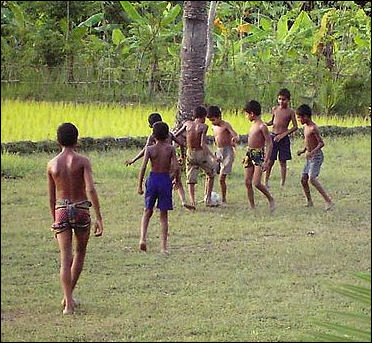
football in BangladeshSoccer (football) is the most popular sport in most developing countries. Visitors are often asked what team they support, and a wrong answer can bring a friendly conversation to a grinding halt. In the cities, when a local team wins a major championship, the streets fill with banner waving supporters sitting out of the windows and on the hoods of honking cars. Fans are often well versed on European club teams and watch every minute of the World Cup.
Soccer is avidly played in every nation in the developing world as it is in the developed world. Throughout history people have played a variety of kicking games. What has evolved into soccer has its roots in medieval Britain and was formalized by England’s Football Association in the mid-19th century . British sailors and merchants spread the sport worldwide. Today there are more than 120 million regular players and millions of others playing on empty lots, school grounds, beaches, streets and playgrounds.
Local matches can be quite rowdy. Hours before they begin, pumped-up male fans (often times women are in short supply) gather outside the stadium in large chanting groups that look more like mobs ready to topple the government than a crowd of spectators on their way to a game. Fans are frisked as they enter the stadium to make sure they aren't carrying any weapons but even so they manage to sneak in smoke bombs and flares that set off when the match starts. During the match fans sing songs with stadium-shaking intensity and shout strings of obscenities at the referees.
At home and in bars and tea houses, men spend a lot of time sitting around the radio or television tuning in to soccer matches. Boys play soccer whenever they have some free time: in an empty lot, a back street or a school courtyard between classes. A smashed coke can or wadded up piece of paper can serve as a ball and a couple of chairs or jackets can serve as a goal. Girls occasionally join in, but they usually play other sports like volleyball or badminton.
In 2006, FIFA distributed $272 million among the teams that participated in the World Cup. The winner gets $20 million. The last place team gets $5.7 million
Cockfighting
Cockfighting is also very popular. Described by some as an "art form" not a sport, it common in rural areas, where many people consider it wholesome, family entertainment. The cock itself is often viewed as a symbol of courage, tenacity, assuredness and masculinity. Prized cocks can sell for more than $1,000 a piece. They are valued for breeding as well as fighting.
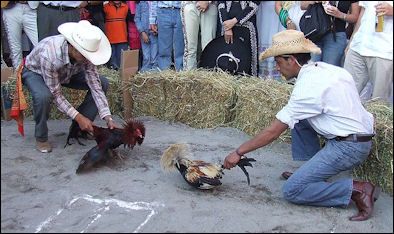
cockfight in Bali Cockfighting predates Christ by at least 500 years. Believed to have originated in China or India, it was practiced by the ancient Greeks, Persians and Romans, who identified it with Eros, the God of Love and passed it on to medieval Europe. The sport reached the pinnacle of its popularity in France and England in the 16th, 17th and 18th century and was finally was banned in England along with other blood sports in 1849, but not before it gave us words like cocky, cocksure, cockpit and cocktail. European colonizers introduced the sport to the Caribbean, Latin America, the Philippines and Indonesia where it is still very popular today.
Cockfights
Cockfights are usually held in pits about the size of a rubber backyard swimming pool. The rules vary somewhat. In some places fighting continues until one bird dies, retreats or can no carry on. In other places, there are rounds like boxing. If a cock's chest is pierced, sometimes the referee will allow a time out so the bird’s owner can rub the cock’s breast with water and blow gently into its mouth.
The cocks are generally outfit with 1½-inch-long, stainless steel spurs. When they are released in the cockfighting pit their neck feathers stiffen and they go after one another like hopping, twirling tornados. Fighting cocks wildly flap their wings, clinch one another, exchange jabs by spreading their wings, punch with their spurs. Eyes are often gouged out chunks of meat are ripped out. One bird usually loses after it heart or head is punctured with blows from the victor’s spurs, and it dies, or its leg or wing is broken and can longer fight.
Good fighters display their fighting spirit when they are young: attacking other birds and even their parents when they are 40 days old.
Pets
Dogs are often sorry-looking animals. Skittish, mangy and lacking in self confidence, they aimlessly scavenge and drift around, cowering and darting around with their tails between their legs, being shooed from one place to the next.
Cats hang out in alleys around garbage cans and are regarded as pests.
People sometimes catch wild animals when they are young and keep them as pets. Children sometimes catch large insects tie and them to a string and keep them as pets.
Image Sources: Wikimedia Commons
Text Sources: New York Times, Washington Post, Los Angeles Times, Times of London, Yomiuri Shimbun, The Guardian, National Geographic, The New Yorker, Time, Newsweek, Reuters, AP, Lonely Planet Guides, Compton’s Encyclopedia and various books and other publications.
Last updated January 2012
